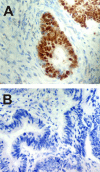cDNA sequencing improves the detection of P53 missense mutations in colorectal cancer
- PMID: 19671129
- PMCID: PMC2731783
- DOI: 10.1186/1471-2407-9-278
cDNA sequencing improves the detection of P53 missense mutations in colorectal cancer
Abstract
Background: Recently published data showed discrepancies between P53 cDNA and DNA sequencing in glioblastomas. We hypothesised that similar discrepancies may be observed in other human cancers.
Methods: To this end, we analyzed 23 colorectal cancers for P53 mutations and gene expression using both DNA and cDNA sequencing, real-time PCR and immunohistochemistry.
Results: We found P53 gene mutations in 16 cases (15 missense and 1 nonsense). Two of the 15 cases with missense mutations showed alterations based only on cDNA, and not DNA sequencing. Moreover, in 6 of the 15 cases with a cDNA mutation those mutations were difficult to detect in the DNA sequencing, so the results of DNA analysis alone could be misinterpreted if the cDNA sequencing results had not also been available. In all those 15 cases, we observed a higher ratio of the mutated to the wild type template by cDNA analysis, but not by the DNA analysis. Interestingly, a similar overexpression of P53 mRNA was present in samples with and without P53 mutations.
Conclusion: In terms of colorectal cancer, those discrepancies might be explained under three conditions: 1, overexpression of mutated P53 mRNA in cancer cells as compared with normal cells; 2, a higher content of cells without P53 mutation (normal cells and cells showing K-RAS and/or APC but not P53 mutation) in samples presenting P53 mutation; 3, heterozygous or hemizygous mutations of P53 gene. Additionally, for heterozygous mutations unknown mechanism(s) causing selective overproduction of mutated allele should also be considered. Our data offer new clues for studying discrepancy in P53 cDNA and DNA sequencing analysis.
Figures



References
-
- Szybka M, Zawlik I, Kulczycka D, Golanska E, Jesien E, Kupnicka D, Stawski R, Piaskowski S, Bieniek E, Zakrzewska M, Kordek R, Liberski PP, Rieske P. Elimination of wild-type P53 mRNA in glioblastomas showing heterozygous mutations of P53. Br J Cancer. 2008;98:1431–3. doi: 10.1038/sj.bjc.6604258. - DOI - PMC - PubMed
-
- Wozniak K, Piaskowski S, Gresner SM, Golanska E, Bieniek E, Bigoszewska K, Sikorska B, Szybka M, Kulczycka-Wojdala D, Zakrzewska M, Zawlik I, Papierz W, Stawski R, Jaskolski DJ, Och W, Sieruta M, Liberski PP, Rieske P. BCR expression is decreased in meningiomas showing loss of heterozygosity of 22q within a new minimal deletion region. Cancer Genet Cytogenet. 2008;183:14–20. doi: 10.1016/j.cancergencyto.2008.01.020. - DOI - PubMed
Publication types
MeSH terms
Substances
LinkOut - more resources
Full Text Sources
Medical
Research Materials
Miscellaneous

